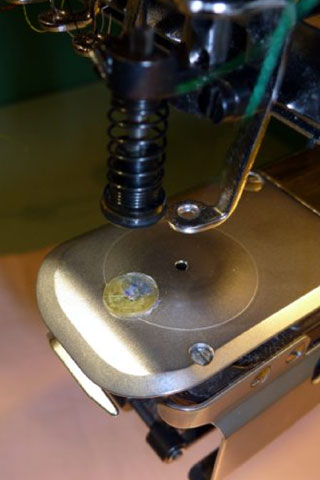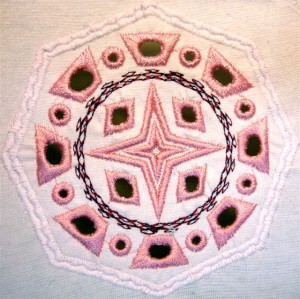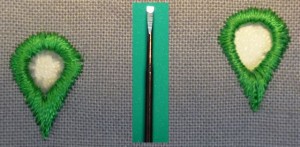With embroidery with boring, holes are created – deliberately. Thereare different ways to achieve this. Even without additional tools, it is possible to create such embroideries on an embroidery machine. In this article, we will not describe the manual technique.
Maybe you have already heard about ‘Madeira embroidery’? This is a kind of embroidery with boring. Round, oval and eye-shaped holes are characteristic of Madeira embroidery. These shapes are often used in flowers and wreaths, but also in butterfly shapes.
There are different special devices for single- and multi-head machines. It also depends on the machine manufacturer as to which boring device is suitable for your embroidery machine.

A bore from an embroidery machine does not look like and does not work like a bore of a wood or metal driller. A boring needle for embroidery, called ‘the bore’, is not a spiral and nor does it rotate. The bore has a slim pyramid-shaped point with sharp edges for cutting. In fact, in embroidery, boring is a cutting technique and not a drilling technique. The name remains from the times of hand embroidery and the type of making the holes. A hole was manually opened in the fabric, without damaging the threads of the web, and then the edges were finished by embroidery. Older embroidery machines also used this technique and the depth of the bore determined the size of the hole.
The bore needle / bore device on modern machines is in most cases placed at the needle bar of the head at the right. In some systems, the bore needle is directly inserted in the needle-bar instead of an embroidery needle. In this case, the hole is cut within the needle-plate hole. Another system works with an extra bore needle holder that is also connected to the needle bar. The inserted bore needle here is in front of the position of the not-inserted embroidery needle. Furthermore, the conventional needle-plate is replaced by a plate that is suitable for such a bore function. It is a bit longer and has a second hole before the conventional plate-hole. This second hole is covered with a flexible material. The borer in the shifted position meets exactly this hole on the flexible plate.
For an embroidered eyelet, the following steps have to be followed for digitising: first, a circle with a running-stitch line with about 2-mm-long stitches has to be digitised. These stitches stabilise the fabric for the subsequent embroidery of the shape and assure a cleanly stitched eyelet. This circle can also be duplicated; however, the stitch holes of the second circle should not meet the ones of the first circle. In the next step, the borer has to be programmed. This procedure varies depending on the software. It is crucial to program for the needle movements of the bore needle either small manual stitches or a running line of 1–1.5-mm-long stitches, because these stitches are actually small cuts that have to separate the fabric and the backing completely. The stitch length depends on the fabric and the backing and should be tested first. A machine stop / change of needle bar are now programmed. For small holes it is sufficient to make a cross-shaped cut within the already-embroidered circle. This has to be done very carefully in order not to damage the embroidered stitches and to leave a small portion of fabric between the hole and the stitch line. Now another stop and a circular satin-stitch line of several millimetres have to be programmed. This line should cover the stabilisation stitches and its inner edge should get very close to the centre of the hole. The design has, therefore, to control three needle-bars, one for embroidering the stabilisation stitches, one for the bore and the third for the covering satin stitches. An oval hole is achieved by a straight cut within the oval over the longer side. This technique allows the creation of holes of up to 10 mm.
Larger holes of different shapes are also possible. However, small cuts are not sufficient here. The fabric has to be cut out; i.e. for a larger circle, a cross-shaped cut is not enough. The inner circle has to be cut at a distance of at least 2 mm from the stabilising stitches. The remaining fabric edge and the width of the satin cover stitches define the finished appearance.
When boring, the thread-breakage monitor has to be deactivated. There are machines with bore devices that automatically deactivate the thread-breakage monitor, when the bore is activated. In addition, the pantograph is moved towards the front (normally 12 mm), so that the bore needle meets the correct position in the design.
For a design that consists only of small cuts for small circles and ovals with and without points, the machine can run normally without interruption. For designs with larger holes, however, where pieces of fabric have to be cut out, the machine should at least be stopped before the cutting edges are embroidered, in order to remove the cut-out fabric pieces.
Traditionally, such bore embroidery is used for curtains, tablecloths and womenswear made from woven fabrics, often together with white work. However, this technique is not limited to woven materials: it also works with our modern materials such as Jersey and polo-piqué. Simple designs receive a special touch with this. The bobbin thread can be chosen in accordance with the upper thread or with the fabric colour.

Talking about cutting, there is another cutting technique that works with embroidery machines: it uses the so-called ‘Venere’ needles. These needles are originally from Italy and they can be used among other techniques for the above-mentioned ‘Madeira’ embroidery. These needles also allow the cutting of bigger holes in any shape in a clean manner. The needles feature a fishtail-shaped cutting edge. Four needles are necessary for cutting any type of shape. Therefore, also four needle-bars have to be fitted with Venere needles using a gauge, each with a different orientation of the cutting point (90°, 0°, 135°, 45°). Depending on the machine, the thread-breakage monitors (upper and bobbin thread) have to be deactivated. On some machines, only the monitors for the specific needle have to be turned off. The work process is identical to the above-described procedure, apart from up to three additional needle-bar changes having to be implemented before embroidering the cover stitches, depending on the shape.

About the author:
Henry Stümer is Manager of the company TexDesign. Besides the main business of consulting and distribution in the embroidery field, TexDesign also does local business in garment decoration. TexDesign was founded in 2002 by Henry’s wife, Barbara, who is responsible for the creative side as well as training. You can contact Henry or Barbara Stümer at info@texdesign.de










